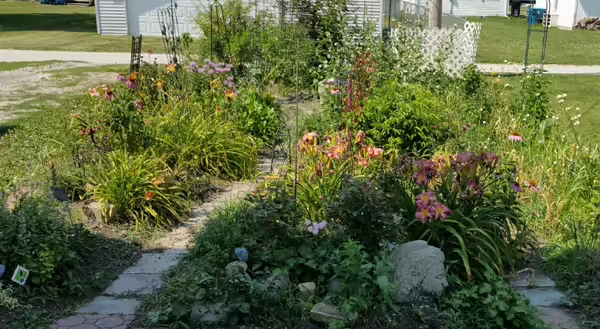
Connie Kostelc has been a Master Gardener volunteer for University of Illinois Extension in Livingston County for the last 22 years. When gardening for edible plants, Connie uses the French intensive raised bed method.
Connie says the look of a French Intensive raised bed garden is different than the conventional raised bed garden. Conventional raised bed gardens use wood boards placed above the ground a foot or two high and filled with soil or compost from an outside source. In a French intensive raised bed, the soil is taken from the adjacent ground to make mounds of soft soil with deep narrow walking paths. The raised soil is usually only 2 to 8 inches high.
The garden is ‘intensive’ because the plants grow close together, which reduces watering needs and weed competition. This gardening practice also utilizes the concepts of successive planting and intercropping to maximize space. Successive planting is the practice of growing a series of different types of crops in the same space in the same growing season. For instance, once radishes are harvested in spring, a warm season crop goes in the same space previously hosting the radishes. Intercropping is the cultivation of two or more crops simultaneously in the same bed. For example, pairing fast-growing beets with slow-growing cabbage. The beets will be harvested before the cabbage spreads out.
In the 1500s, these gardens were used in French cities such as Paris where garden space was at a premium. Planting this way allowed more plants to be planted in a smaller garden areas. While this technique had a major resurgence in the late 1800s and early 1900s in Europe, it really wasn't until the 1960s that it became commonly practiced in the US.
Connie’s gardening friends encouraged her to start her Central Illinois garden in this manner. She says “the advantages of this technique not only allows you to plant things closer together, it also allows the soil to warm up because the sunlight gets to the sides of the mounds earlier than on flat soil.”
In Connie’s 24 years of gardening in this method, she has never stepped on a beds and has only tilled once—at the time of installation because of the compacted soil. Connie grows everything from asparagus to zucchini using this method, and experiments with anything new she can find.
Since so many things in her garden are perennials they also don't need as much supplemental watering. However, she does use a soaker hose on annual plants such as lettuces and tomatoes. She is vigilant watching her garden for signs on drought. Just like a mother can sense when her baby is hungry, you learn to know when your garden needs water.